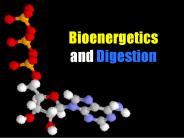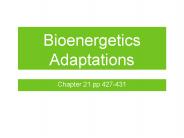Bioenergetics PowerPoint PPT Presentations
All Time
Recommended
Bioenergetics The Big Picture - energy flows through - matter recycles Producers = Autotrophs - organisms which can make their food - plants, algae, some bacteria ...
| PowerPoint PPT presentation | free to download
Tehran University of Medical Sciences (TUMS) How we make ATP BIOENERGETICS Power plant of cells Dr. Parvin Pasalar To understand the differences between ...
| PowerPoint PPT presentation | free to view
Title: BIOENERGETICS Author: Cheryl Massengale Last modified by: cmassengale Created Date: 7/28/2005 3:47:44 PM Document presentation format: On-screen Show
| PowerPoint PPT presentation | free to view
Title: Chapter 3 Subject: Bioenergetics Author: Brian Parr Created Date: 2/11/2000 2:36:49 PM Document presentation format: Company
| PowerPoint PPT presentation | free to view
BIOENERGETICS Bioenergetics The study of energy in living systems (environments) and the organisms (plants and animals) that utilizing them. Energy Capacity to ...
| PowerPoint PPT presentation | free to download
Bioenergetics Intro/Chpt 14 Catabolism & energy prod n in cells (Fig. 4, p487) Glycolysis Intermediary metabolism ATP production Mitochondrial Chloroplast ...
| PowerPoint PPT presentation | free to download
Title: Slide 1 Author: paula hale Last modified by: mk Created Date: 2/5/2000 12:00:17 PM Document presentation format: On-screen Show (4:3) Company
| PowerPoint PPT presentation | free to view
... something that is oxidized in the course of ... CO2 is the common highly Oxidized form of Carbon ... Recall that both FAD and NAD can oxidize other molecules ...
| PowerPoint PPT presentation | free to view
Nutrient Role in Bioenergetics Bioenergetics Bioenergetics refers to the flow of energy within a living system. Energy is the capacity to do work.
| PowerPoint PPT presentation | free to view
The process by which plants, use the energy from sunlight to produce sugar, ... acid cycle is called an amphibolic pathway because it participates in both ...
| PowerPoint PPT presentation | free to view
Tehran University of Medical Sciences (TUMS) How we make ATP BIOENERGETICS Power plant of cells Dr. Parvin Pasalar To understand the differences between ...
| PowerPoint PPT presentation | free to view
Glycogen supply is limited; 300-400 grams in muscle, and 70-100 grams in liver ... Fast glycolysis has commonly been called anaerobic glycolysis. ...
| PowerPoint PPT presentation | free to view
Is there a great divide between the living and the nonliving? ... Energy from complex molecules simple molecules used to maintain order. ...
| PowerPoint PPT presentation | free to view
Metabolites, characteristics, anabolic, catabolic, localization of pathways ... thermic refers to heat energy. 19. In other words. A ---- B G '1. B ---- C G '2 ...
| PowerPoint PPT presentation | free to view
Chemical reaction that requires a net input of energy. ... Anabolism or Catabolism. Endergonic or Exergonic. BOTH. BOTH. BOTH. 30. Ready for the test? ...
| PowerPoint PPT presentation | free to view
most use cellular respiration. ATP = Adenosine triphosphate ... Cellular Respiration Ch. 9 ... See page 228. Summary of ATP production in Cellular Respiration ...
| PowerPoint PPT presentation | free to view
The study of energy supply, utilization and dissipation ... Nonutilized and absorbed compounds from food. End products of metabolism ...
| PowerPoint PPT presentation | free to view
Introduction to Respiration. Enzymes are very specific ... Cellular Respiration is a biochemical process that aerobically harvests energy ...
| PowerPoint PPT presentation | free to view
Bioenergetics. Lecture 5. Lecture 5. Detail of Light Reactions. Detail of Calvin Cycle ... Plants that only use the Calvin Cycle to fix carbon are know as C3 plants. ...
| PowerPoint PPT presentation | free to view
Enthalpy. The first law of thermodynamics says total energy conserved: D U = q - w ... D H is the changes in enthalpy (ie. heat exchanged) ...
| PowerPoint PPT presentation | free to view
Activated Carrier Molecules Are Essential for Biosynthesis. Figure 2-55 ... using it for biosynthesis. Special activated carrier. molecules: ...
| PowerPoint PPT presentation | free to view
granum) which contain chlorophyll and other important molecules. ... Chlorophyll. Photosystems. energy. transfer. energy transfer. energy transfer. energy transfer ...
| PowerPoint PPT presentation | free to view
Bioenergetics is the field of biochemistry concerned with the transformation and ... Chemical battery converts chemical energy into ... ATP in bioluminescence ...
| PowerPoint PPT presentation | free to view
Biosynthesis. 2. Mechanical work. 3. Concentration work and ion pumps. 4. Heat. Biosynthesis ... phototrophs, which allows biosynthesis and growth in plants. ...
| PowerPoint PPT presentation | free to view
Do accelerate rate of reaction (kinetics) Highly specific for substrate/reactant ... No relationship between G and rate of a reaction (kinetics) ...
| PowerPoint PPT presentation | free to view
free-energy, G: expresses the amount of energy available to do work in a ... is highly exergonic, the molecule is kinetically stable at pH 7 because the ...
| PowerPoint PPT presentation | free to view
Remember: this is only under standard conditions. There are two different quantities: ... initial concentration of each component is 1 M, the pH is 7, the ...
| PowerPoint PPT presentation | free to view
Oxidative Phosphorylation 2: chemiosmotic mechanism of ADP phosphorylation ... The generation of a proton motive force across a biomembrane is a common ...
| PowerPoint PPT presentation | free to view
Title: Biyoenerjetikler Subject: Bioenergetics Author: Brian Parr Last modified by: alex nowicky Created Date: 2/11/2000 2:36:49 PM Document presentation format
| PowerPoint PPT presentation | free to download
Metabolic Pathways Cooperate To: Obtain Chemical Energy by: a. Capturing Solar Energy, or. b. Oxidizing Energy Rich Chemicals from the Environment.
| PowerPoint PPT presentation | free to view
They are involved in the building up of simpler molecules into more-complex ones ... Cofactor. Polypeptide. Enzyme Saturation. Substrate. Product ...
| PowerPoint PPT presentation | free to view
Title: Bioenergetics and Metabolism Author: David R. Gang Last modified by: Roger Miesfeld Created Date: 3/19/2006 6:02:14 AM Document presentation format
| PowerPoint PPT presentation | free to view
... Reactions The Lock-and-Key Model of Enzyme Action Diagnostic Value of Measuring Enzyme Activity in the Blood Classification of Enzymes Example of the ...
| PowerPoint PPT presentation | free to view
Bioenergetics and Digestion We ll be discussing Trends and Various Strategies Used by Organisms to Process Food Process of Digestion in Man Disorders of the Human ...
| PowerPoint PPT presentation | free to download
short high-intensity intervals. power exercises. rest interval; 3 ... High Intensity, Continuous Training. Why is there a decrease in lactic acid production? ...
| PowerPoint PPT presentation | free to download
Laboratory of Bioenergetics main ... mechanical Video system for behavioral analyses Automatic extraction apparatus B chi B-811 Automatic extraction apparatus B chi ...
| PowerPoint PPT presentation | free to view
If the citrate cycle is an engine, what is the fuel, the energy output, and the ... results in the transfer of 2 e- to the FAD moiety, which in turn, passes the ...
| PowerPoint PPT presentation | free to view
Bioenergetics of Exercise And Training chapter 2 Bioenergetics of Exercise and Training Joel T. Cramer, PhD; CSCS,*D; NSCA-CPT,*D; FNSCA ...
| PowerPoint PPT presentation | free to view
This is the chemical structure of which glycolytic metabolite? ... levels of intestinal lactose causes osmosis of water into the intestine leading ...
| PowerPoint PPT presentation | free to view
Fish and silkworms contain the enzyme thiaminase, which degrades thiamin. ... the symptoms of beriberi caused by ingesting too much raw fish and silkworm. ...
| PowerPoint PPT presentation | free to view
day. All processes are temp. and size dependent ... Food and Agricultural Organization of the United Nations, Rome, Italy. 83 p. ...
| PowerPoint PPT presentation | free to view
Bioenergetics and Glycolysis Getting the E out of C gluconeogenesis Making glucose from pyruvate In liver Uses same enzymes as glycolysis except where nonequilibrium ...
| PowerPoint PPT presentation | free to view
Section 5: Bioenergetics 1. Bioenergetics & Metabolism 10/4/05 Bioenergetics & biological processes How do organisms use energy to sustain life? for most organisms ...
| PowerPoint PPT presentation | free to view
Conversion of pyruvate to Acetyl-CoA (acetyl-coenzyme A). Produces CO2 ... Condenses Acetyl-CoA to yield citrate (gives the cycle its name). - Recovers CoASH. ...
| PowerPoint PPT presentation | free to view
In the reaction 2 Na Cl2, 2 Na 2 Cl-, what is being oxidized and what is being ... Wasted muscles and wrist drop are tell-tale symptoms of lead poisoning. ...
| PowerPoint PPT presentation | free to view
CHAPTER 3 Bioenergetics, Enzymes, and Metabolism * * * * * * * * * * * * * * * * * * * * * * * * * * * * * * * * * * * * * * * * Separating Catabolic and Anabolic ...
| PowerPoint PPT presentation | free to download
Title: The Cell, 5e Author: Betz, Joan Last modified by: l-admin Created Date: 10/16/2000 7:08:56 PM Document presentation format: On-screen Show (4:3)
| PowerPoint PPT presentation | free to view
Metabolism of glucose by yeast under anaerobic conditions leads to the ... P is the reaction that puts the lysis in glycolysis (lysis means splitting) ...
| PowerPoint PPT presentation | free to view
... etc. Pitcher plant ... Pinguicula gigantea Sundew Drosera capensis Venus fly trap Dionaea muscipula Images from wikipedia.org Different types depending ...
| PowerPoint PPT presentation | free to download
Light harvesting: first part of photosynthesis. plants (chloroplasts) and bacteria ... Most of life's processes are driven by ATP. But some processes are driven ...
| PowerPoint PPT presentation | free to view
... Blue = enzyme Red = substrate Different enzymes have different optimum conditions Inhibitors Feedback Inhibition for Metabolic Regulation ...
| PowerPoint PPT presentation | free to download
Recruits those muscle fiber also. These rxn can be self-limiting. Build up of AMP ... Anaerobic energy production is inefficient but fast. Low ATP yielding ...
| PowerPoint PPT presentation | free to view
Two Types of Energy. 1. Potential energy stored energy ... GIRAFFE. HEAT. LION. Plants capture sun's energy. How do we get energy out of plants and animals? ...
| PowerPoint PPT presentation | free to view
Bioenergetics and Thermodynamics CHEM 7784 Biochemistry Professor Bensley Introduction and Chapter 13.1 Bioenergetics and Thermodynamics Differences between metabolic ...
| PowerPoint PPT presentation | free to view
Chapter 4 Exercise Metabolism and Bioenergetics Objectives After this presentation, the participant will be able to: Describe the primary methods of how the body ...
| PowerPoint PPT presentation | free to view
























































